Reflective Assignment Report: Assessing Business Project Performance
VerifiedAdded on 2020/06/04
|9
|2485
|33
Report
AI Summary
This report is a reflective assignment analyzing the success and failure of a business project. It begins with an introduction outlining the purpose of the report, which is to reflect on the student's learning experience. The report then dives into a detailed discussion of the successful aspects of the project, such as problem identification, data collection from primary and secondary sources, and realistic scenario planning. The report also addresses the failures, specifically focusing on the improper implementation of solutions and the lack of an implementation matrix. The student incorporates feedback from the lecturer, highlighting strengths such as communication and brainstorming, and weaknesses such as leadership skills. The student also provides a SWOT analysis to identify strategies for maintaining strengths and overcoming weaknesses, along with recommendations for future improvements. The report concludes with a summary of key findings and recommendations for future similar assignments, emphasizing the importance of proper resource management and effective implementation.
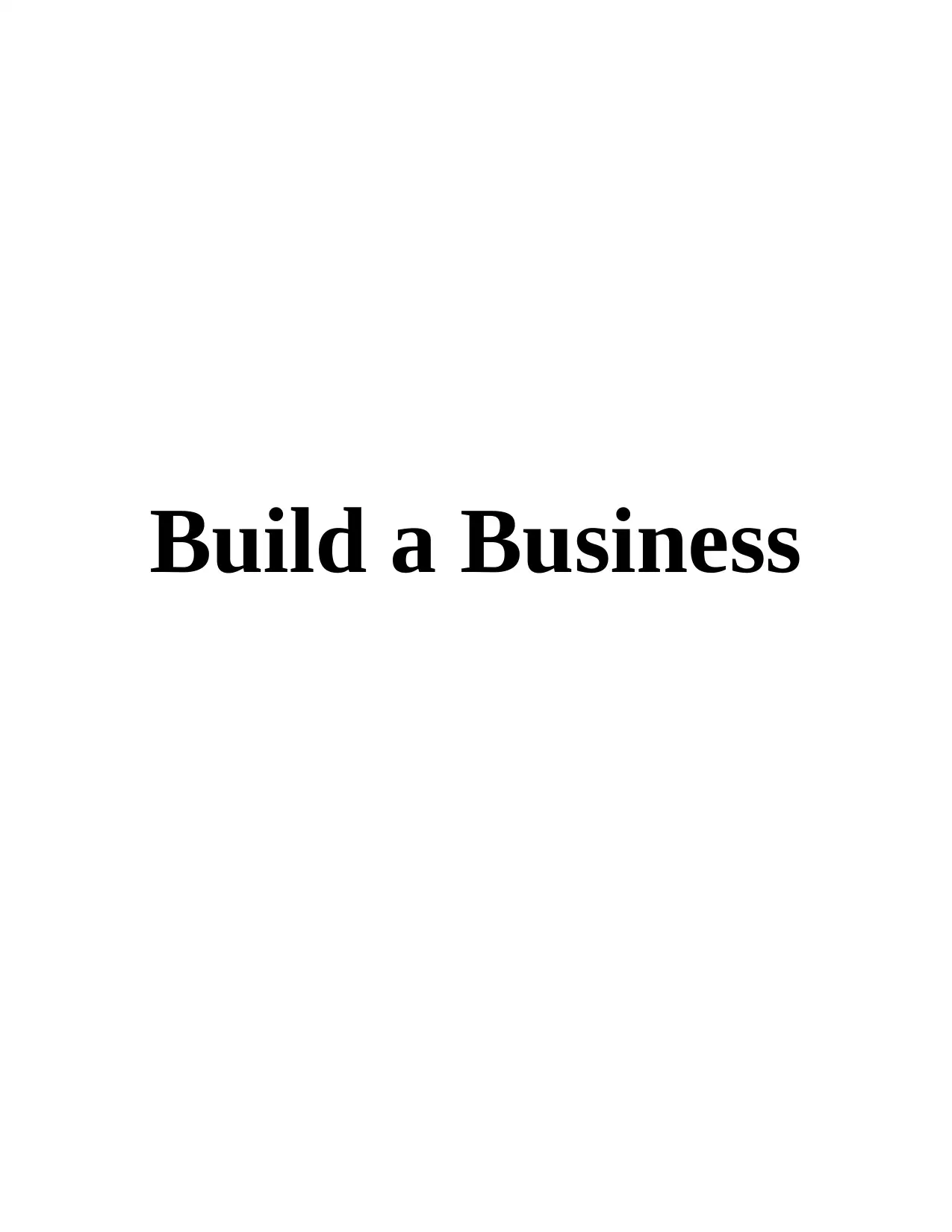
Build a Business
Paraphrase This Document
Need a fresh take? Get an instant paraphrase of this document with our AI Paraphraser
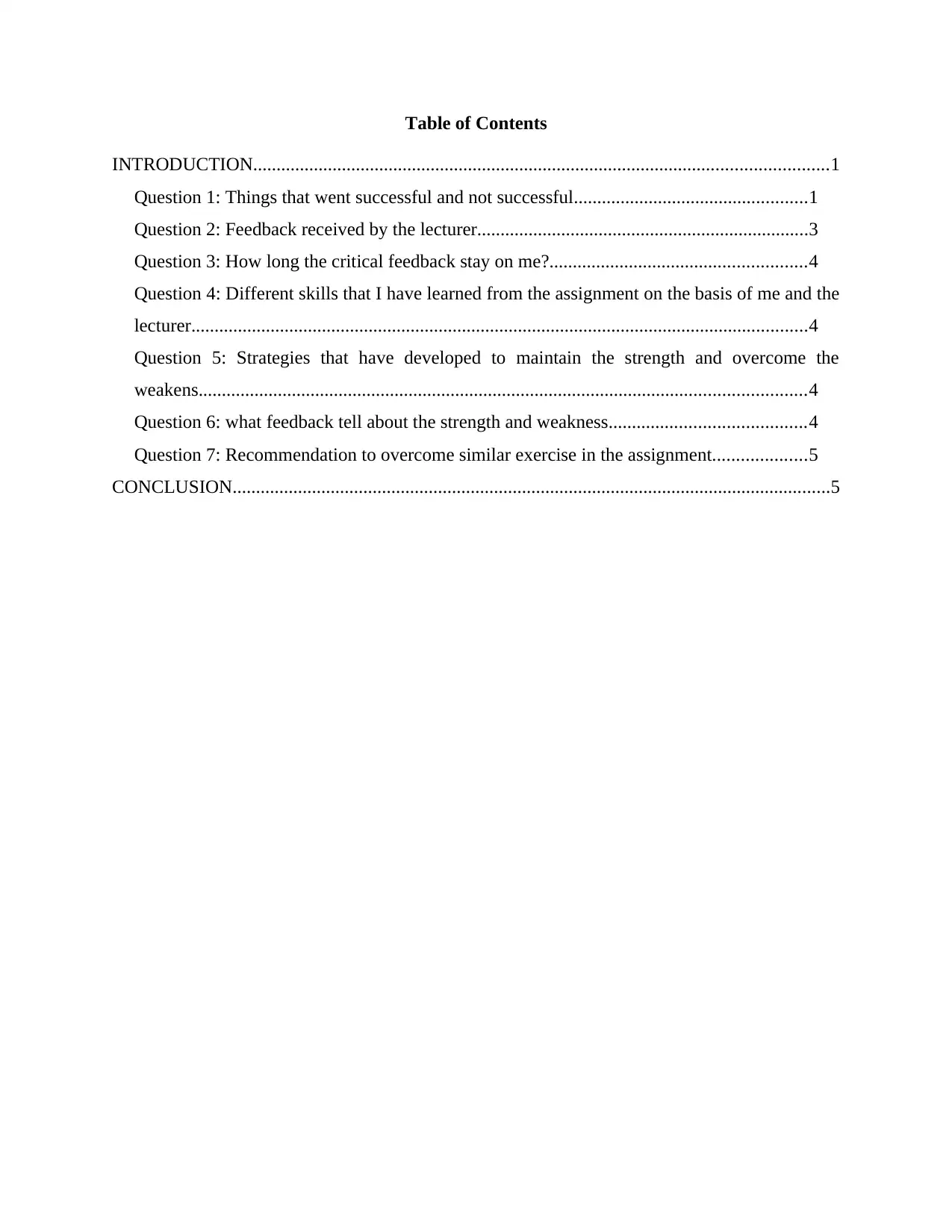
Table of Contents
INTRODUCTION...........................................................................................................................1
Question 1: Things that went successful and not successful..................................................1
Question 2: Feedback received by the lecturer.......................................................................3
Question 3: How long the critical feedback stay on me?.......................................................4
Question 4: Different skills that I have learned from the assignment on the basis of me and the
lecturer....................................................................................................................................4
Question 5: Strategies that have developed to maintain the strength and overcome the
weakens..................................................................................................................................4
Question 6: what feedback tell about the strength and weakness..........................................4
Question 7: Recommendation to overcome similar exercise in the assignment....................5
CONCLUSION................................................................................................................................5
INTRODUCTION...........................................................................................................................1
Question 1: Things that went successful and not successful..................................................1
Question 2: Feedback received by the lecturer.......................................................................3
Question 3: How long the critical feedback stay on me?.......................................................4
Question 4: Different skills that I have learned from the assignment on the basis of me and the
lecturer....................................................................................................................................4
Question 5: Strategies that have developed to maintain the strength and overcome the
weakens..................................................................................................................................4
Question 6: what feedback tell about the strength and weakness..........................................4
Question 7: Recommendation to overcome similar exercise in the assignment....................5
CONCLUSION................................................................................................................................5
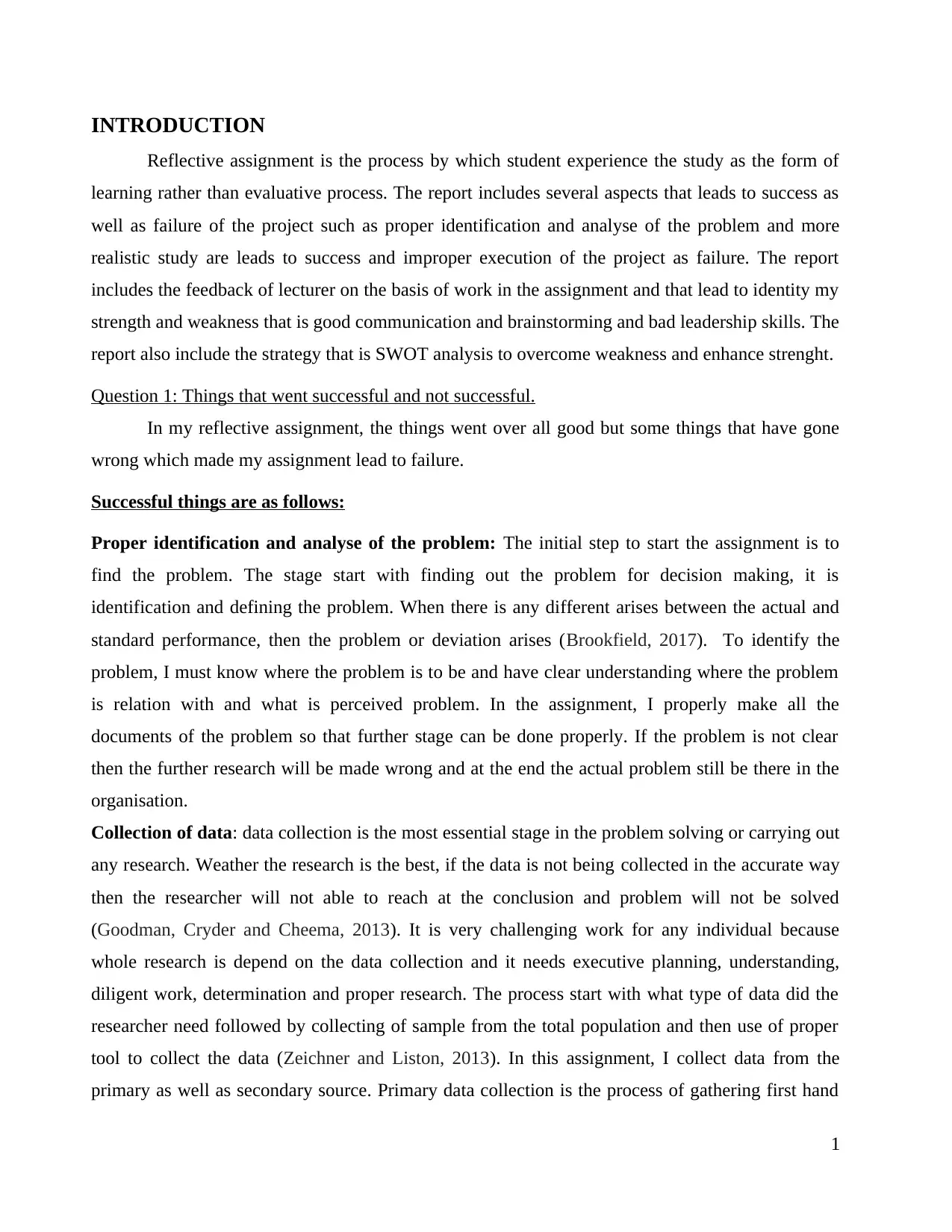
INTRODUCTION
Reflective assignment is the process by which student experience the study as the form of
learning rather than evaluative process. The report includes several aspects that leads to success as
well as failure of the project such as proper identification and analyse of the problem and more
realistic study are leads to success and improper execution of the project as failure. The report
includes the feedback of lecturer on the basis of work in the assignment and that lead to identity my
strength and weakness that is good communication and brainstorming and bad leadership skills. The
report also include the strategy that is SWOT analysis to overcome weakness and enhance strenght.
Question 1: Things that went successful and not successful.
In my reflective assignment, the things went over all good but some things that have gone
wrong which made my assignment lead to failure.
Successful things are as follows:
Proper identification and analyse of the problem: The initial step to start the assignment is to
find the problem. The stage start with finding out the problem for decision making, it is
identification and defining the problem. When there is any different arises between the actual and
standard performance, then the problem or deviation arises (Brookfield, 2017). To identify the
problem, I must know where the problem is to be and have clear understanding where the problem
is relation with and what is perceived problem. In the assignment, I properly make all the
documents of the problem so that further stage can be done properly. If the problem is not clear
then the further research will be made wrong and at the end the actual problem still be there in the
organisation.
Collection of data: data collection is the most essential stage in the problem solving or carrying out
any research. Weather the research is the best, if the data is not being collected in the accurate way
then the researcher will not able to reach at the conclusion and problem will not be solved
(Goodman, Cryder and Cheema, 2013). It is very challenging work for any individual because
whole research is depend on the data collection and it needs executive planning, understanding,
diligent work, determination and proper research. The process start with what type of data did the
researcher need followed by collecting of sample from the total population and then use of proper
tool to collect the data (Zeichner and Liston, 2013). In this assignment, I collect data from the
primary as well as secondary source. Primary data collection is the process of gathering first hand
1
Reflective assignment is the process by which student experience the study as the form of
learning rather than evaluative process. The report includes several aspects that leads to success as
well as failure of the project such as proper identification and analyse of the problem and more
realistic study are leads to success and improper execution of the project as failure. The report
includes the feedback of lecturer on the basis of work in the assignment and that lead to identity my
strength and weakness that is good communication and brainstorming and bad leadership skills. The
report also include the strategy that is SWOT analysis to overcome weakness and enhance strenght.
Question 1: Things that went successful and not successful.
In my reflective assignment, the things went over all good but some things that have gone
wrong which made my assignment lead to failure.
Successful things are as follows:
Proper identification and analyse of the problem: The initial step to start the assignment is to
find the problem. The stage start with finding out the problem for decision making, it is
identification and defining the problem. When there is any different arises between the actual and
standard performance, then the problem or deviation arises (Brookfield, 2017). To identify the
problem, I must know where the problem is to be and have clear understanding where the problem
is relation with and what is perceived problem. In the assignment, I properly make all the
documents of the problem so that further stage can be done properly. If the problem is not clear
then the further research will be made wrong and at the end the actual problem still be there in the
organisation.
Collection of data: data collection is the most essential stage in the problem solving or carrying out
any research. Weather the research is the best, if the data is not being collected in the accurate way
then the researcher will not able to reach at the conclusion and problem will not be solved
(Goodman, Cryder and Cheema, 2013). It is very challenging work for any individual because
whole research is depend on the data collection and it needs executive planning, understanding,
diligent work, determination and proper research. The process start with what type of data did the
researcher need followed by collecting of sample from the total population and then use of proper
tool to collect the data (Zeichner and Liston, 2013). In this assignment, I collect data from the
primary as well as secondary source. Primary data collection is the process of gathering first hand
1
⊘ This is a preview!⊘
Do you want full access?
Subscribe today to unlock all pages.

Trusted by 1+ million students worldwide
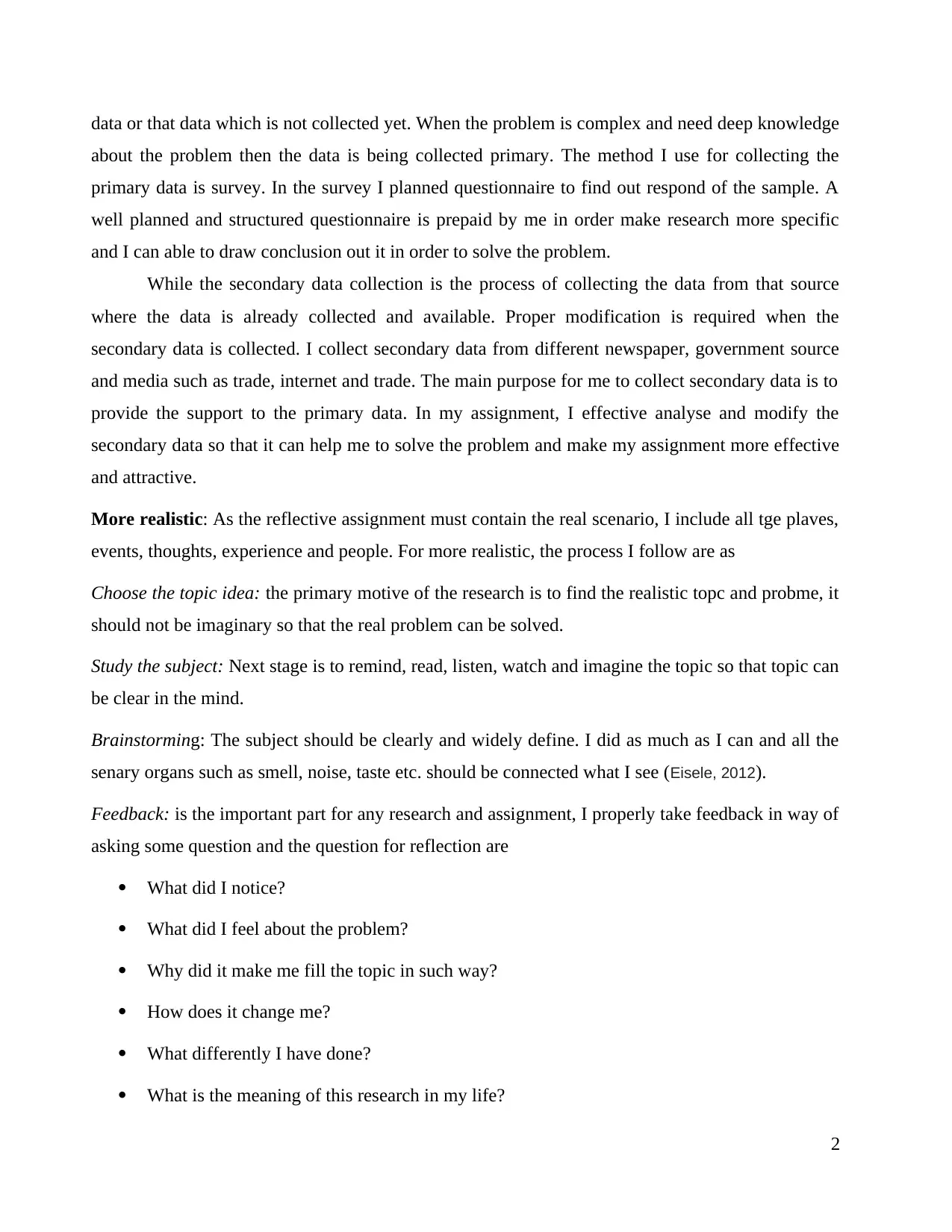
data or that data which is not collected yet. When the problem is complex and need deep knowledge
about the problem then the data is being collected primary. The method I use for collecting the
primary data is survey. In the survey I planned questionnaire to find out respond of the sample. A
well planned and structured questionnaire is prepaid by me in order make research more specific
and I can able to draw conclusion out it in order to solve the problem.
While the secondary data collection is the process of collecting the data from that source
where the data is already collected and available. Proper modification is required when the
secondary data is collected. I collect secondary data from different newspaper, government source
and media such as trade, internet and trade. The main purpose for me to collect secondary data is to
provide the support to the primary data. In my assignment, I effective analyse and modify the
secondary data so that it can help me to solve the problem and make my assignment more effective
and attractive.
More realistic: As the reflective assignment must contain the real scenario, I include all tge plaves,
events, thoughts, experience and people. For more realistic, the process I follow are as
Choose the topic idea: the primary motive of the research is to find the realistic topc and probme, it
should not be imaginary so that the real problem can be solved.
Study the subject: Next stage is to remind, read, listen, watch and imagine the topic so that topic can
be clear in the mind.
Brainstorming: The subject should be clearly and widely define. I did as much as I can and all the
senary organs such as smell, noise, taste etc. should be connected what I see (Eisele, 2012).
Feedback: is the important part for any research and assignment, I properly take feedback in way of
asking some question and the question for reflection are
What did I notice?
What did I feel about the problem?
Why did it make me fill the topic in such way?
How does it change me?
What differently I have done?
What is the meaning of this research in my life?
2
about the problem then the data is being collected primary. The method I use for collecting the
primary data is survey. In the survey I planned questionnaire to find out respond of the sample. A
well planned and structured questionnaire is prepaid by me in order make research more specific
and I can able to draw conclusion out it in order to solve the problem.
While the secondary data collection is the process of collecting the data from that source
where the data is already collected and available. Proper modification is required when the
secondary data is collected. I collect secondary data from different newspaper, government source
and media such as trade, internet and trade. The main purpose for me to collect secondary data is to
provide the support to the primary data. In my assignment, I effective analyse and modify the
secondary data so that it can help me to solve the problem and make my assignment more effective
and attractive.
More realistic: As the reflective assignment must contain the real scenario, I include all tge plaves,
events, thoughts, experience and people. For more realistic, the process I follow are as
Choose the topic idea: the primary motive of the research is to find the realistic topc and probme, it
should not be imaginary so that the real problem can be solved.
Study the subject: Next stage is to remind, read, listen, watch and imagine the topic so that topic can
be clear in the mind.
Brainstorming: The subject should be clearly and widely define. I did as much as I can and all the
senary organs such as smell, noise, taste etc. should be connected what I see (Eisele, 2012).
Feedback: is the important part for any research and assignment, I properly take feedback in way of
asking some question and the question for reflection are
What did I notice?
What did I feel about the problem?
Why did it make me fill the topic in such way?
How does it change me?
What differently I have done?
What is the meaning of this research in my life?
2
Paraphrase This Document
Need a fresh take? Get an instant paraphrase of this document with our AI Paraphraser

How can I use this to help someone?
How does this research be related to the other's life?
What hurdles it creates in my life?
What is going good and what is going bad in the research and my life?
What is my reaction on the topic?
How the research affect me, what and till what extent?
What did I experience from the research?
Thing that go bad in my assignment.
Implementation: It is the process of execution and carrying out the practice and plan,
method, design, idea, specification, model, standard so that problem can be solved.
Implementation is very important part for the any project or assignment. As it is last stage
for any problem solving and decision making process but plays very important role. Proper
implementation matrix is done but in my assignment, implementation goes wrong which
lead to failure. Implantation matrix includes finding out the improvement in the project and
focus on the people and resources that is utilised properly (Van Overschee and De Moor,
2012). Matrix helps the researcher to where the problem is, where it is heading, what is
going wrong and when researcher will reach the target. In my assignment I did not cover the
implementation matrix which leads to in-proper use of resources and man power and leads
to assignment failure.
Question 2: Feedback received by the lecturer
The assignment is submitted to the lecturer, he properly analysed the assignment and some
good things as well as bad things are communicated by him to me. He told me that the over all
assignment is good in terms of identification of the problem, selecting and analyse of the problem.
The assignment is good in information collection as the data is collected in both primary and
secondary way where questionnaire is well prepared and cover all the aspect of the problem and the
secondary data is properly modified so that it can provide support to the primary data (Dana and
Yendol-Hoppey, 2014). The problem is realistic where this assignment help to solve the real world
problem and cover all the analysis tool such as research philosophy, design etc. The problem
3
How does this research be related to the other's life?
What hurdles it creates in my life?
What is going good and what is going bad in the research and my life?
What is my reaction on the topic?
How the research affect me, what and till what extent?
What did I experience from the research?
Thing that go bad in my assignment.
Implementation: It is the process of execution and carrying out the practice and plan,
method, design, idea, specification, model, standard so that problem can be solved.
Implementation is very important part for the any project or assignment. As it is last stage
for any problem solving and decision making process but plays very important role. Proper
implementation matrix is done but in my assignment, implementation goes wrong which
lead to failure. Implantation matrix includes finding out the improvement in the project and
focus on the people and resources that is utilised properly (Van Overschee and De Moor,
2012). Matrix helps the researcher to where the problem is, where it is heading, what is
going wrong and when researcher will reach the target. In my assignment I did not cover the
implementation matrix which leads to in-proper use of resources and man power and leads
to assignment failure.
Question 2: Feedback received by the lecturer
The assignment is submitted to the lecturer, he properly analysed the assignment and some
good things as well as bad things are communicated by him to me. He told me that the over all
assignment is good in terms of identification of the problem, selecting and analyse of the problem.
The assignment is good in information collection as the data is collected in both primary and
secondary way where questionnaire is well prepared and cover all the aspect of the problem and the
secondary data is properly modified so that it can provide support to the primary data (Dana and
Yendol-Hoppey, 2014). The problem is realistic where this assignment help to solve the real world
problem and cover all the analysis tool such as research philosophy, design etc. The problem
3

analysed by the lecturer was in the implementation of the solution and the resources is not properly
used which leads to the failure of my assignment.
Question 3: How long the critical feedback stay on me?
The critical feedback given by the lecturer was on the implementation of the assignment. He
wants me do all the execution process again and use implementation matrix. He told me that all the
resources such as man power, financial and inventory is not used properly. As the execution process
is very big and need long time to solve the problem. This critical feedback linger for long period on
me as I need to start whole process again from the start and use all the resources in the effective and
efficient way.
Question 4: Different skills that I have learned from the assignment on the basis of me and the
lecturer.
The most important skills required in the reflective assignment is writing skills. It is the
fundamental skill for the purpose specially in writing any essay. If the writing skill is not proper
than it is very difficult to write the reflective essay. So I have learned how to write and in which
format, to the essay (Jørgensen, 2016). Another skills I develop from that essay is communication,
while survey you need to ask some question to the participant, in order to make him/her understand
the topic and question, proper communication is important. I have also learned creativity and
innovative thinking, as the problem was complex, I need to identify innovative ideas and insights so
that it can be solved.
Question 5: Strategies that have developed to maintain the strength and overcome the weakens.
SWOT analysis is the effective tool and strategy by which I can able to analyse the
assignment strength, weakness, opportunities and threats. This is the tool which helps me to find
internal as well as external environment. Through my strength I can able to grab the opportunities
and fight against the threats (Wilhelm, 2016). The weakness under my project is I dint implement
the solution properly but further as per my strength such as man power and inventory I van able to
remove the weakness and implement my project properly and effectively. This changes help me to
take care in the implementation process so that this problem will not arise in the future.
Question 6: what feedback tell about the strength and weakness.
The feedback which is given by the lecturer help me find my strength and weakness in the
basis of my this assignment. The strength I have is good communication skills where I properly
communicate with the responded when survey is made and this skill help to collect data properly.
4
used which leads to the failure of my assignment.
Question 3: How long the critical feedback stay on me?
The critical feedback given by the lecturer was on the implementation of the assignment. He
wants me do all the execution process again and use implementation matrix. He told me that all the
resources such as man power, financial and inventory is not used properly. As the execution process
is very big and need long time to solve the problem. This critical feedback linger for long period on
me as I need to start whole process again from the start and use all the resources in the effective and
efficient way.
Question 4: Different skills that I have learned from the assignment on the basis of me and the
lecturer.
The most important skills required in the reflective assignment is writing skills. It is the
fundamental skill for the purpose specially in writing any essay. If the writing skill is not proper
than it is very difficult to write the reflective essay. So I have learned how to write and in which
format, to the essay (Jørgensen, 2016). Another skills I develop from that essay is communication,
while survey you need to ask some question to the participant, in order to make him/her understand
the topic and question, proper communication is important. I have also learned creativity and
innovative thinking, as the problem was complex, I need to identify innovative ideas and insights so
that it can be solved.
Question 5: Strategies that have developed to maintain the strength and overcome the weakens.
SWOT analysis is the effective tool and strategy by which I can able to analyse the
assignment strength, weakness, opportunities and threats. This is the tool which helps me to find
internal as well as external environment. Through my strength I can able to grab the opportunities
and fight against the threats (Wilhelm, 2016). The weakness under my project is I dint implement
the solution properly but further as per my strength such as man power and inventory I van able to
remove the weakness and implement my project properly and effectively. This changes help me to
take care in the implementation process so that this problem will not arise in the future.
Question 6: what feedback tell about the strength and weakness.
The feedback which is given by the lecturer help me find my strength and weakness in the
basis of my this assignment. The strength I have is good communication skills where I properly
communicate with the responded when survey is made and this skill help to collect data properly.
4
⊘ This is a preview!⊘
Do you want full access?
Subscribe today to unlock all pages.

Trusted by 1+ million students worldwide
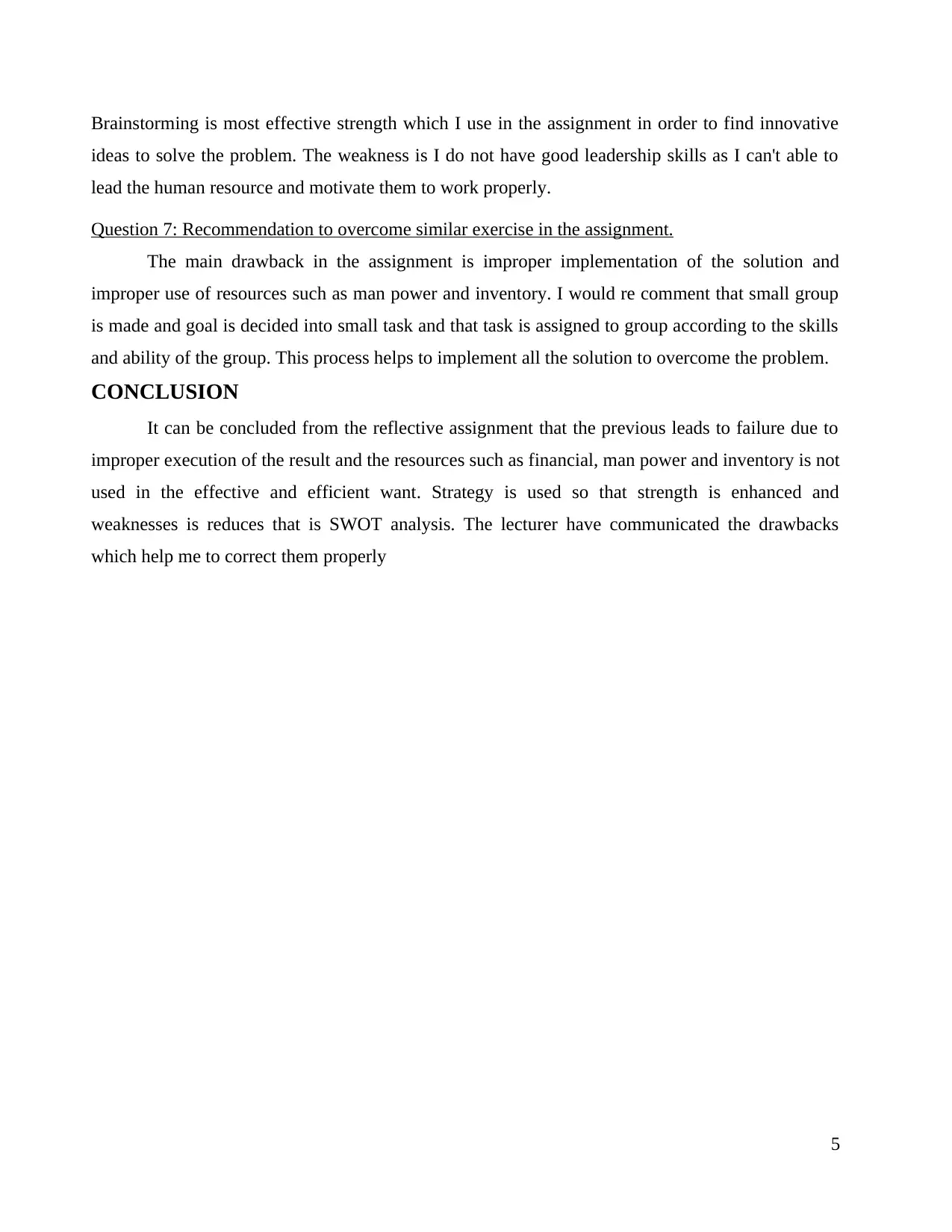
Brainstorming is most effective strength which I use in the assignment in order to find innovative
ideas to solve the problem. The weakness is I do not have good leadership skills as I can't able to
lead the human resource and motivate them to work properly.
Question 7: Recommendation to overcome similar exercise in the assignment.
The main drawback in the assignment is improper implementation of the solution and
improper use of resources such as man power and inventory. I would re comment that small group
is made and goal is decided into small task and that task is assigned to group according to the skills
and ability of the group. This process helps to implement all the solution to overcome the problem.
CONCLUSION
It can be concluded from the reflective assignment that the previous leads to failure due to
improper execution of the result and the resources such as financial, man power and inventory is not
used in the effective and efficient want. Strategy is used so that strength is enhanced and
weaknesses is reduces that is SWOT analysis. The lecturer have communicated the drawbacks
which help me to correct them properly
5
ideas to solve the problem. The weakness is I do not have good leadership skills as I can't able to
lead the human resource and motivate them to work properly.
Question 7: Recommendation to overcome similar exercise in the assignment.
The main drawback in the assignment is improper implementation of the solution and
improper use of resources such as man power and inventory. I would re comment that small group
is made and goal is decided into small task and that task is assigned to group according to the skills
and ability of the group. This process helps to implement all the solution to overcome the problem.
CONCLUSION
It can be concluded from the reflective assignment that the previous leads to failure due to
improper execution of the result and the resources such as financial, man power and inventory is not
used in the effective and efficient want. Strategy is used so that strength is enhanced and
weaknesses is reduces that is SWOT analysis. The lecturer have communicated the drawbacks
which help me to correct them properly
5
Paraphrase This Document
Need a fresh take? Get an instant paraphrase of this document with our AI Paraphraser
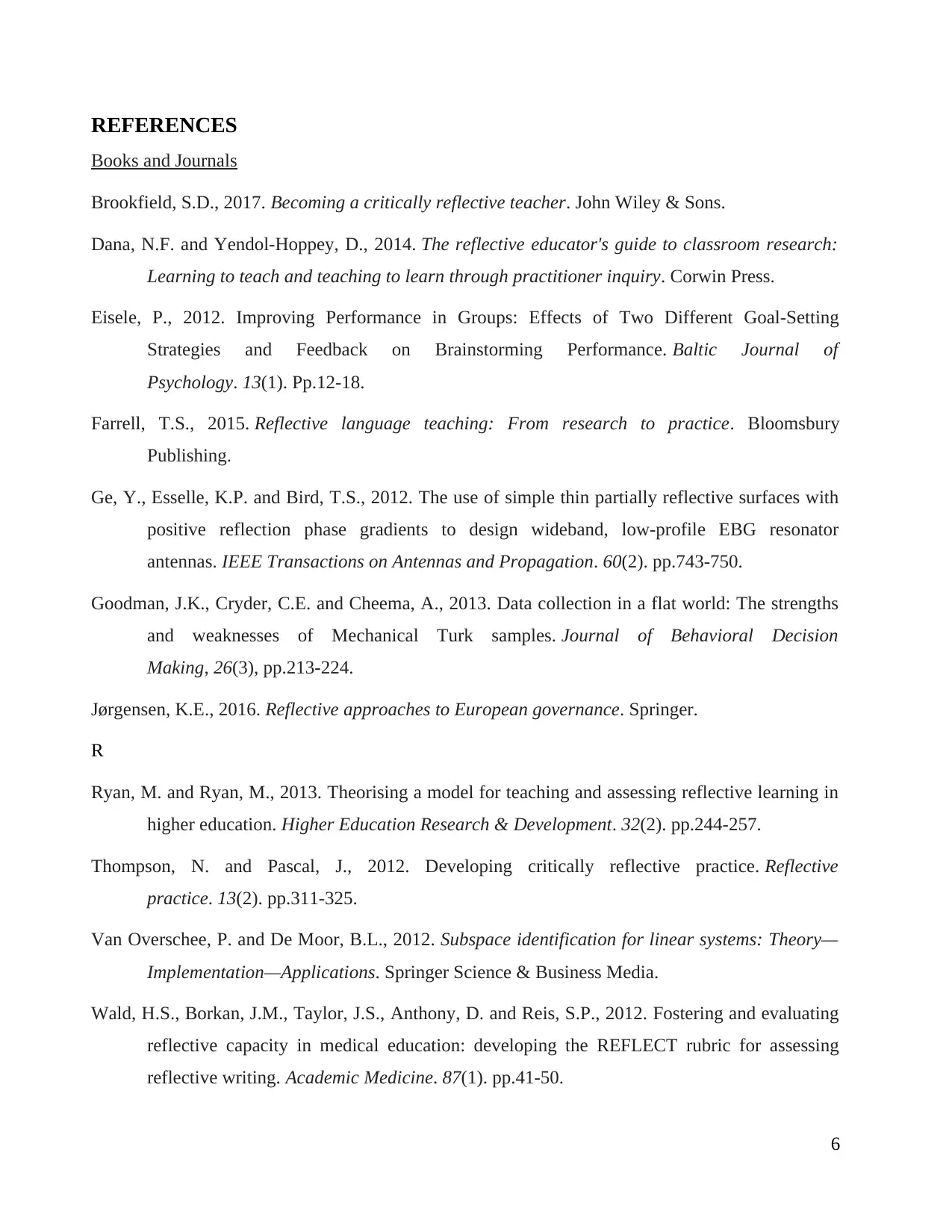
REFERENCES
Books and Journals
Brookfield, S.D., 2017. Becoming a critically reflective teacher. John Wiley & Sons.
Dana, N.F. and Yendol-Hoppey, D., 2014. The reflective educator's guide to classroom research:
Learning to teach and teaching to learn through practitioner inquiry. Corwin Press.
Eisele, P., 2012. Improving Performance in Groups: Effects of Two Different Goal-Setting
Strategies and Feedback on Brainstorming Performance. Baltic Journal of
Psychology. 13(1). Pp.12-18.
Farrell, T.S., 2015. Reflective language teaching: From research to practice. Bloomsbury
Publishing.
Ge, Y., Esselle, K.P. and Bird, T.S., 2012. The use of simple thin partially reflective surfaces with
positive reflection phase gradients to design wideband, low-profile EBG resonator
antennas. IEEE Transactions on Antennas and Propagation. 60(2). pp.743-750.
Goodman, J.K., Cryder, C.E. and Cheema, A., 2013. Data collection in a flat world: The strengths
and weaknesses of Mechanical Turk samples. Journal of Behavioral Decision
Making, 26(3), pp.213-224.
Jørgensen, K.E., 2016. Reflective approaches to European governance. Springer.
R
Ryan, M. and Ryan, M., 2013. Theorising a model for teaching and assessing reflective learning in
higher education. Higher Education Research & Development. 32(2). pp.244-257.
Thompson, N. and Pascal, J., 2012. Developing critically reflective practice. Reflective
practice. 13(2). pp.311-325.
Van Overschee, P. and De Moor, B.L., 2012. Subspace identification for linear systems: Theory—
Implementation—Applications. Springer Science & Business Media.
Wald, H.S., Borkan, J.M., Taylor, J.S., Anthony, D. and Reis, S.P., 2012. Fostering and evaluating
reflective capacity in medical education: developing the REFLECT rubric for assessing
reflective writing. Academic Medicine. 87(1). pp.41-50.
6
Books and Journals
Brookfield, S.D., 2017. Becoming a critically reflective teacher. John Wiley & Sons.
Dana, N.F. and Yendol-Hoppey, D., 2014. The reflective educator's guide to classroom research:
Learning to teach and teaching to learn through practitioner inquiry. Corwin Press.
Eisele, P., 2012. Improving Performance in Groups: Effects of Two Different Goal-Setting
Strategies and Feedback on Brainstorming Performance. Baltic Journal of
Psychology. 13(1). Pp.12-18.
Farrell, T.S., 2015. Reflective language teaching: From research to practice. Bloomsbury
Publishing.
Ge, Y., Esselle, K.P. and Bird, T.S., 2012. The use of simple thin partially reflective surfaces with
positive reflection phase gradients to design wideband, low-profile EBG resonator
antennas. IEEE Transactions on Antennas and Propagation. 60(2). pp.743-750.
Goodman, J.K., Cryder, C.E. and Cheema, A., 2013. Data collection in a flat world: The strengths
and weaknesses of Mechanical Turk samples. Journal of Behavioral Decision
Making, 26(3), pp.213-224.
Jørgensen, K.E., 2016. Reflective approaches to European governance. Springer.
R
Ryan, M. and Ryan, M., 2013. Theorising a model for teaching and assessing reflective learning in
higher education. Higher Education Research & Development. 32(2). pp.244-257.
Thompson, N. and Pascal, J., 2012. Developing critically reflective practice. Reflective
practice. 13(2). pp.311-325.
Van Overschee, P. and De Moor, B.L., 2012. Subspace identification for linear systems: Theory—
Implementation—Applications. Springer Science & Business Media.
Wald, H.S., Borkan, J.M., Taylor, J.S., Anthony, D. and Reis, S.P., 2012. Fostering and evaluating
reflective capacity in medical education: developing the REFLECT rubric for assessing
reflective writing. Academic Medicine. 87(1). pp.41-50.
6
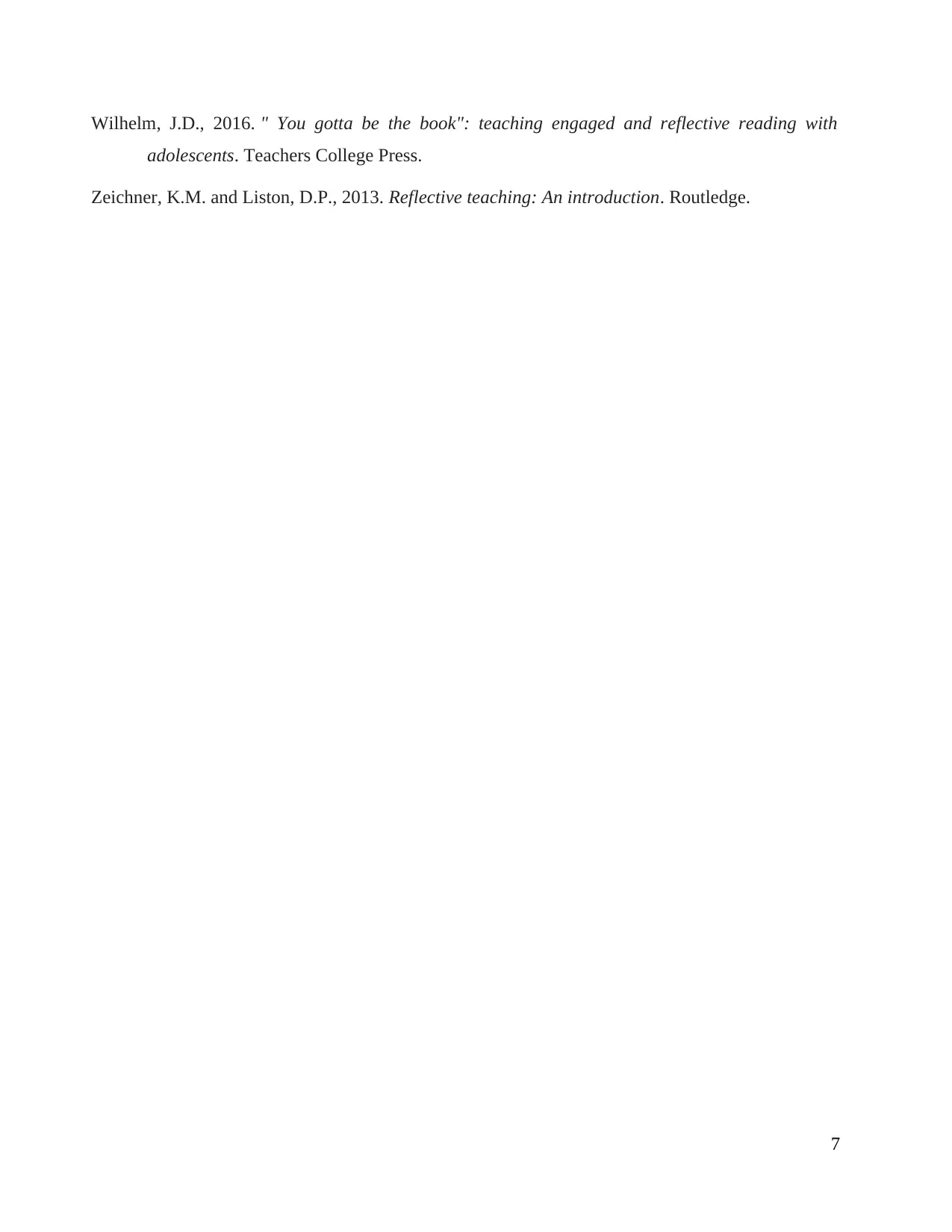
Wilhelm, J.D., 2016. " You gotta be the book": teaching engaged and reflective reading with
adolescents. Teachers College Press.
Zeichner, K.M. and Liston, D.P., 2013. Reflective teaching: An introduction. Routledge.
7
adolescents. Teachers College Press.
Zeichner, K.M. and Liston, D.P., 2013. Reflective teaching: An introduction. Routledge.
7
⊘ This is a preview!⊘
Do you want full access?
Subscribe today to unlock all pages.

Trusted by 1+ million students worldwide
1 out of 9
Related Documents
Your All-in-One AI-Powered Toolkit for Academic Success.
+13062052269
info@desklib.com
Available 24*7 on WhatsApp / Email
![[object Object]](/_next/static/media/star-bottom.7253800d.svg)
Unlock your academic potential
Copyright © 2020–2025 A2Z Services. All Rights Reserved. Developed and managed by ZUCOL.





